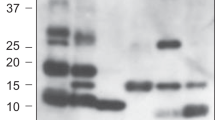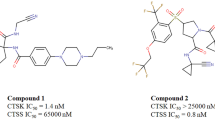Abstract
Human kallikrein-related peptidases (KLKs) of serine protease family are known to be expressed in diverse cancers via dysregulated protease activation. KLKs have been associated with pathological angiogenesis of tumor metastasis. KLK-14 expression is highly involved in ovarian, breast, and prostate tumors through explicitly catalyzing the Extracellular matrix protein (fibronectin) hydrolysis. Hence KLK-14 protein is considered the target to study its interaction with curcumin and its derivatives. The present work focuses on creating the 3D model of KLK-14 (Target Protein) by using the homology modeling technique. The 3D model of the target protein is MD Simulated and validated via the Ramachandran plot (90.80% of amino acids in the favorable region) and ProSA-webserver (z-value = − 6.18) indicating the overall reliability of the built model. Further Protein–Protein docking with its natural substrate (Fibronectin) validates the active site residues. Virtual Screening using an In-house library of Curcumin derivatives was performed by AutoDock Vina 4.2 (PyRx software). Curcumin and its derivative (BisDemethoxycurcumin) bind to the target protein (Catalytic triad residues Arg 65, Phe66, Leu67, His83, Arg86, Tyr174, and Ser220) with Binding free energy in the range of − 9.4 to − 7.4 kcal/mol, and also permissible ADME indicating substrate specificity to act as a potential inhibitor of angiogenesis.
Graphical abstract








Similar content being viewed by others
Data availability
All data generated or analyzed during this study are included in this published article [and its supplementary information files].
References
Ahola V, Aittokallio T, Vihinen M, Uusipaikka E (2006) A statistical score for assessing the quality of multiple sequence alignments. BMC Bioinf. https://doi.org/10.1186/1471-2105-7-484
Artimo P, Jonnalagedda M, Arnold K et al (2012) ExPASy: SIB bioinformatics resource portal. Nucleic Acids Res. https://doi.org/10.1093/nar/gks400
Bandi J, Nambigari N (2021) Identification of novel anticancer agent by in silico methods for inhibition of KLK-12 protein. Asian J Org Med Chem 6:13–23. https://doi.org/10.14233/ajomc.2021.ajomc-p304
Betsholtz C (2014) Double function at the blood–brain barrier. Nature. https://doi.org/10.1038/nature13339
Borgoño CA, Diamandis EP (2004) The emerging roles of human tissue kallikreins in cancer. Nat Rev Cancer. https://doi.org/10.1038/nrc1474
Borgoño CA, Michael IP, Diamandis EP (2004) Human tissue kallikreins: physiologic roles and applications in cancer. Mol Cancer Res 2:257–280
Borgoño CA, Michael IP, Komatsu N et al (2007a) A potential role for multiple tissue kallikrein serine proteases in epidermal desquamation. J Biol Chem. https://doi.org/10.1074/jbc.M607567200
Borgoño CA, Michael IP, Shaw JLV et al (2007b) Expression and functional characterization of the cancer-related serine protease, human tissue kallikrein 14. J Biol Chem. https://doi.org/10.1074/jbc.M608348200
Breier A, Gibalova L, Seres M et al (2013) New insight into P-glycoprotein as a drug target. Anti-Cancer Agents Med Chem (anti-Cancer Agents). https://doi.org/10.2174/187152013804487380
Cerqueira NMFSA, Gesto D, Oliveira EF et al (2015) Receptor-based virtual screening protocol for drug discovery. Arch Biochem Biophys. https://doi.org/10.1016/j.abb.2015.05.011
Chang MW, Ayeni C, Breuer S, Torbett BE (2010) Virtual screening for HIV protease inhibitors: a comparison of autodock 4 and vina. PLoS ONE. https://doi.org/10.1371/journal.pone.0011955
Cuff JA, Barton GJ (1999) Evaluation and improvement of multiple sequence methods for protein secondary structure prediction. Proteins Struct Funct Genet. https://doi.org/10.1002/(SICI)1097-0134(19990301)34:4%3c508::AID-PROT10%3e3.0.CO;2-4
Daina A, Zoete V (2016) A BOILED-egg to predict gastrointestinal absorption and brain penetration of small molecules. ChemMedChem. https://doi.org/10.1002/cmdc.201600182
Dallakyan S, Olson AJ (2015) Small-molecule library screening by docking with PyRx
Drozdetskiy A, Cole C, Procter J, Barton GJ (2015) JPred4: a protein secondary structure prediction server. Nucleic Acids Res. https://doi.org/10.1093/nar/gkv332
Duhovny D, Nussinov R, Wolfson HJ (2002) Efficient unbound docking of rigid molecules. In: Lecture notes in computer science (including subseries lecture notes in artificial intelligence and lecture notes in bioinformatics)
Dundas J, Ouyang Z, Tseng J et al (2006) CASTp: computed atlas of surface topography of proteins with structural and topographical mapping of functionally annotated residues. Nucleic Acids Res. https://doi.org/10.1093/nar/gkl282
Eisenberg D, Lüthy R, Bowie JU (1997) VERIFY3D: assessment of protein models with three-dimensional profiles. Methods Enzymol 227:396–404. https://doi.org/10.1016/S0076-6879(97)77022-8
Emami N, Diamandis EP (2008) Utility of kallikrein-related peptidases (KLKs) as cancer biomarkers. Clin Chem. https://doi.org/10.1373/clinchem.2008.105189
Feig M (2016) Local protein structure refinement via molecular dynamics simulations with locPREFMD. J Chem Inf Model 56(7):1304–1312. https://doi.org/10.1021/acs.jcim.6b00222
Folkman J (1995) Clinical applications of research on angiogenesis. N Engl J Med. https://doi.org/10.1056/NEJM199512283332608
Gasteiger E (2003) ExPASy: the proteomics server for in-depth protein knowledge and analysis. Nucleic Acids Res. https://doi.org/10.1093/nar/gkg563
Gramatica P (2020) Principles of QSAR Modeling. Int J Quant Struct Relationsh. https://doi.org/10.4018/IJQSPR.20200701.oa1
Guex N, Peitsch MC (1997) SWISS-MODEL and the swiss-Pdb viewer: an environment for comparative protein modeling. Electrophoresis. https://doi.org/10.1002/elps.1150181505
Huang Y, Zhao J, Song Q et al (2016) Virtual screening and experimental validation of novel histone deacetylase inhibitors. BMC Pharmacol Toxicol. https://doi.org/10.1186/s40360-016-0075-8
Hynes RO (1990) Fibronectins. Springer-Verlag, Berlin. https://doi.org/10.1007/978-1-4612-3264-3. (ISBN 978-0-387-97050-9)
Johnson M, Zaretskaya I, Raytselis Y et al (2008) NCBI BLAST: a better web interface. Nucleic Acids Res. https://doi.org/10.1093/nar/gkn201
Kalinska M, Meyer-Hoffert U, Kantyka T, Potempa J (2016) Kallikreins–the melting pot of activity and function. Biochimie. https://doi.org/10.1016/j.biochi.2015.09.023
Kaplan W, Feenstra KA, Heringa J et al (2001) Swiss-PDB viewer (deep view). Brief Bioinform 2(2):195–197. https://doi.org/10.1093/bib/2.2.195
Karlin S, Altschul SF (1990) Methods for assessing the statistical significance of molecular sequence features by using general scoring schemes. Proc Natl Acad Sci. https://doi.org/10.1073/pnas.87.6.2264
Kato K, Nakayoshi T, Fukuyoshi S, Kurimoto E, Oda A (2017) Validation of molecular dynamics simulations for prediction of three-dimensional structures of small proteins. Molecules 22:1716. https://doi.org/10.3390/molecules22101716
Kerfeld CA, Scott KM (2011) Using BLAST to teach “E-value-tionary” concepts. PLoS Biol 9(2):e1001014. https://doi.org/10.1371/journal.pbio.1001014
Kim S, Chen J, Cheng T et al (2021) PubChem in 2021: new data content and improved web interfaces. Nucleic Acids Res. https://doi.org/10.1093/nar/gkaa971
Kitchen DB, Decornez H, Furr JR, Bajorath J (2004) Docking and scoring in virtual screening for drug discovery: methods and applications. Nat Rev Drug Discov. https://doi.org/10.1038/nrd1549
Kurkcuoglu Z, Koukos PI, Citro N et al (2018) Performance of HADDOCK and a simple contact-based protein–ligand binding affinity predictor in the D3RGrand Challenge 2. J Comput-Aided Mol Des 32:175–185. https://doi.org/10.1007/s10822-017-0049-y
Laskowski RA, MacArthur MW, Moss DS, Thornton JM (1993) PROCHECK: a program to check the stereochemical quality of protein structures. J Appl Crystallogr. https://doi.org/10.1107/S0021889892009944
Lavecchia A, Giovanni C (2013) Virtual screening strategies in drug discovery: a critical review. Curr Med Chem. https://doi.org/10.2174/09298673113209990001
Lilja H (1985) A kallikrein-like serine protease in prostatic fluid cleaves the predominant seminal vesicle protein. J Clin Invest. https://doi.org/10.1172/JCI112185
Lin Y-C, Wang C-C, Chen I-S et al (2013) TIPdb: a database of anticancer, antiplatelet, and antituberculosis phytochemicals from indigenous plants in Taiwan. Sci World J. https://doi.org/10.1155/2013/736386
Lionta E, Spyrou G, Vassilatis D, Cournia Z (2014) Structure-based virtual screening for drug discovery: principles, applications and recent advances. Curr Top Med Chem. https://doi.org/10.2174/1568026614666140929124445
Lovering F, Bikker J, Humblet C (2009) Escape from Flatland: increasing saturation as an approach to improving clinical success. J Med Chem. https://doi.org/10.1021/jm901241e
Mishra BB, Tiwari VK (2011) Natural products: an evolving role in future drug discovery. Eur J Med Chem. https://doi.org/10.1016/j.ejmech.2011.07.057
Nambigari N, Mustyala KK, Malkhed V, Kondagari B, Potlapally SR, Dulapalli R, Vurupturi U (2012) Angiogenesis: an insilico approach to angiogenic phenotype. J Pharm Res 5:583–588
Nelson KM, Dahlin JL, Bisson J et al (2017) The essential medicinal chemistry of curcumin. J Med Chem. https://doi.org/10.1021/acs.jmedchem.6b00975
Nishida N, Yano H, Nishida T et al (2006) Angiogenesis in cancer. Vasc Health Risk Manag. https://doi.org/10.2147/vhrm.2006.2.3.213
Pertsemlidis A, Fondon JW (2001) Having a BLAST with bioinformatics (and avoiding BLASTphemy). Genome Biol. https://doi.org/10.1186/gb-2001-2-10-reviews2002
Ramani VC, Haun RS (2008) The extracellular matrix protein fibronectin is a substrate for kallikrein 7. Biochem Biophys Res Commun. https://doi.org/10.1016/j.bbrc.2008.03.021
Ritchie TJ, Ertl P, Lewis R (2011) The graphical representation of ADME-related molecule properties for medicinal chemists. Drug Discov Today. https://doi.org/10.1016/j.drudis.2010.11.002
Šali A, Potterton L, Yuan F et al (1995) Evaluation of comparative protein modeling by MODELLER. Proteins Struct Funct Genet. https://doi.org/10.1002/prot.340230306
Schneidman-Duhovny D, Inbar Y, Nussinov R, Wolfson HJ (2005) PatchDock and SymmDock: servers for rigid and symmetric docking. Nucleic Acids Res. https://doi.org/10.1093/nar/gki481
Soding J, Biegert A, Lupas AN (2005) The HHpred interactive server for protein homology detection and structure prediction. Nucleic Acids Res 33:W244–W248. https://doi.org/10.1093/nar/gki408
Sussman JL, Lin D, Jiang J et al (1998) Protein data bank (PDB): database of three-dimensional structural information of biological macromolecules. Acta Crystallogr Sect D Biol Crystallogr. https://doi.org/10.1107/S0907444998009378
Tian S, Wang J, Li Y et al (2015) The application of in silico drug-likeness predictions in pharmaceutical research. Adv Drug Deliv Rev. https://doi.org/10.1016/j.addr.2015.01.009
Tsai HH, Tsai CJ, Ma B, Nussinov R (2004) In silico protein design by combinatorial assembly of protein building blocks. Protein Sci 13(10):2753–2765. https://doi.org/10.1110/ps.04774004
Vadija R, Mustyala KK, Nambigari N et al (2016) Homology modeling and virtual screening studies of FGF-7 protein—a structure-based approach to design new molecules against tumor angiogenesis. J Chem Biol. https://doi.org/10.1007/s12154-016-0152-x
Vangone A, Schaarschmidt J, Koukos P, Geng C, Citro N, Trellet ME, Xue LC, Bonvin AM (2019) Large-scale prediction of binding affinity in protein–small ligand complexes: the PRODIGYLIG web server. Bioinformatics 35(9):1585–1587. https://doi.org/10.1093/bioinformatics/bty816
Varmus H (2006) The new era in cancer research. Science. https://doi.org/10.1126/science.1126758
Vellanki SP, Dulapalli R, Kondagari B et al (2018) Structural evaluation and binding mode analysis of CCL19 and CCR7 proteins—identification of novel leads for rheumatic and autoimmune diseases: an insilico study. Interdiscip Sci Comput Life Sci. https://doi.org/10.1007/s12539-017-0212-0
Webber MM, Waghray A, Bello D (1995) Prostate-specific antigen, a serine protease, facilitates human prostate cancer cell invasion. Clin Cancer Res 1:1089–1094
Wiederstein M, Sippl MJ (2007) ProSA-web: interactive web service for the recognition of errors in three-dimensional structures of proteins. Nucleic Acids Res. https://doi.org/10.1093/nar/gkm290
Wijelath ES, Rahman S, Namekata M et al (2006) Heparin-II domain of fibronectin is a vascular endothelial growth factor-binding domain. Circ Res. https://doi.org/10.1161/01.RES.0000246849.17887.66
Zaveri K, Chaitanya AK, Reddy IB (2015) Virtual screening and docking studies of identified potential drug target: polysaccharide deacetylase in Bacillus anthracis. Int Lett Nat Sci. https://doi.org/10.18052/www.scipress.com/ILNS.34.70
Zimmermann L, Stephens A, Nam SZ, Rau D, Kübler J, Lozajic M, Gabler F, Söding J, Lupas AN, Alva V (2018) A completely reimplemented MPI bioinformatics toolkit with a new HHpred server at its core. J Mol Biol S0022–2836(17):30587–30589
Acknowledgements
The authors JB, MV and NNT are thankful to The Head, Department of Chemistry and the Principal, University College of Science, Saifabad, Osmania University, Hyderabad for providing the facilities to carry out this work.
Funding
No financial support from any agency.
Author information
Authors and Affiliations
Contributions
JB: “Data curation, Formal analysis, Investigation; Validation; Visualization”; VM: Data Interpretation and Roles/Writing–review & editing.
Corresponding authors
Ethics declarations
Conflict of interest
On behalf of all authors, the corresponding author states that there is no conflict of interest.
Additional information
Publisher's Note
Springer Nature remains neutral with regard to jurisdictional claims in published maps and institutional affiliations.
Supplementary Information
Below is the link to the electronic supplementary material.
Rights and permissions
About this article
Cite this article
Bandi, J., Malkhed, V. & Nambigari, N. An insilico study of KLK-14 protein and its inhibition with curcumin and its derivatives. Chem. Pap. 76, 4955–4966 (2022). https://doi.org/10.1007/s11696-022-02209-w
Received:
Accepted:
Published:
Issue Date:
DOI: https://doi.org/10.1007/s11696-022-02209-w




